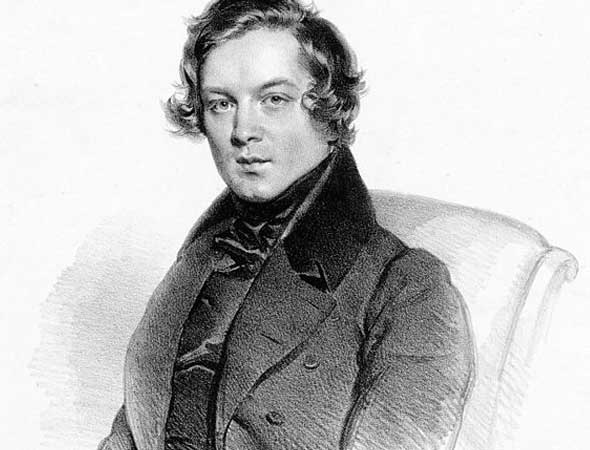R. SCHUMANN: Konzertstück for Four Horns
by Jeff Counts
THE COMPOSER– ROBERT SCHUMANN (1810–1856) – Robert Schumann’s legacy is defined by two things—his critical catalog of romantic-era masterpieces and his lifelong struggles with physical and mental infirmity. A faulty hand put an end to his dreams of life as a virtuoso pianist, and his deeply troubled mind eventually ended everything else. There were, however, periods of relative calm in the soul of this most tragic of geniuses, and the last half of the 1840s found him “recovered” and producing excellent work. The list from this time includes the Piano Concerto, his one and only opera Genoveva and a dramatic overture to accompany Byron’s Manfred.

THE HISTORY– Tucked neatly in and amongst the titans of this productive moment was a rather odd little duck of a piece. The Konzertstück for Four Horns and Orchestra is as singular now as it was when Schumann composed it. No instrument projected the mood of Germanic Romanticism quite like the horn. Both a beloved relic and a flag-bearer of nationalistic potential, the horn was subtle enough (in the right hands) to span generations of musical thought. Valves were coming into fashion for the horn in the middle years of the 19th century, an innovation which hinted at incredible virtuosic possibilities that Schumann was eager to exploit. He was living in Dresden in 1849 and while there he heard performances by Joseph-Rudolph Lewy, one of the first great masters of the valve horn. The inspiration of those experiences led to the creation of something truly novel in the Konzertstück, a concerto grosso of sorts that placed not one but four horns in front of the orchestra as soloists. Like any good composer of ambition, Schumann chose not just to merely confirm the capabilities of this exciting new instrument, he sought to thoroughly challenge them. The Konzertstück was written to showcase the talents of the Leipzig Gewandhaus Orchestra horn section but, given how daunting the work still is today, it must have given those poor chaps a fit at the premiere. As feature work for multiple horns, no composer has ever equaled it. Few have even tried. From technical dexterity to high register fearlessness, much is asked of any quartet brave enough to take it on. They must execute the hairpin passage work with grace and courage, all without the safety net of a string section between themselves and the audience. Cast in three fleet movements, the Konzertstück is an exemplar of Schumann’s efforts to tackle more complex formal structures and orchestral configurations. The brief period of good health and creative fertility in the late 1840s would not last, sadly, but its many gems still shine.
THE WORLD– Elsewhere in 1849, gold was discovered in California, Dostoevsky was arrested and nearly executed in St. Petersburg, Edgar Allen Poe died under mysterious circumstances, and Charles Dickens published David Copperfield .
THE CONNECTION– The most recent Utah Symphony Masterworks Series performance of the Konzertstück was way back in 2000. Keith Lockhart conducted.











